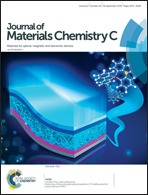BiOBr-assisted hydrothermal synthesis of hierarchical Bi4(GeO4)3/Zn2GeO4 microspheres for optical sensor application
Abstract
Dual-emitting hierarchical Bi4(GeO4)3/Zn2GeO4 hybrid microspheres have been prepared by a facile one-pot hydrothermal synthesis of Zn2GeO4 with the addition of pre-synthesized BiOBr nanoplates. The phase composition and morphology evolution of the Bi4(GeO4)3/Zn2GeO4 composites are investigated depending on the amounts of BiOBr precursor used in the hydrothermal process. The photoluminescence peaks at 412 and 532 nm for the as-prepared Bi4(GeO4)3/Zn2GeO4 are ascribed to Bi3+ emission and defect-related centers in the Zn2GeO4 component, respectively, and the features show a quenching response toward a temperature increase. The fluorescence intensity ratio (FIR) of Bi3+: 3P1–1S0 (412 nm) to the defect emission center of Zn2GeO4 (532 nm) can be exploited as a self-calibrated temperature index for potential thermometer applications. The maximum relative sensitivity (Sr) is 3.96% °C−1 in the temperature range of 20 °C to 100 °C. This work expands the rational design strategy for controllable particle morphology and structure modulation, and further explores their synergetic distinctive properties and potential optical sensor applications.



 Please wait while we load your content...
Please wait while we load your content...